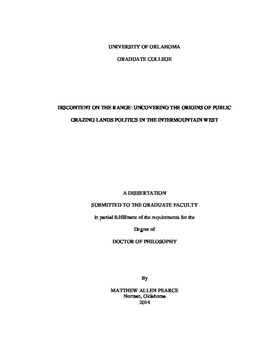| dc.description.abstract | Recent conflicts between ranchers, environmentalists, and federal range management experts on western public lands are a product of different perceptions of the landscape that crystallized by the middle of the twentieth century. Western stockgrowers depend upon a variety of rangeland ecosystems during the year in order to sustain their animals. By moving livestock from lower to higher elevations throughout the region, however, they often cross several political boundaries. By the middle of the twentieth century, western rangelands lay under a variety of jurisdictions—private, state, and federal—and ranchers often combined lands from all three areas into a seasonal forage supply. Federal rangelands, especially those organized under the Taylor Grazing Act of 1934, played a crucial role in allowing stockgrowers to utilize western public lands for the purposes of livestock grazing. Thus, this dissertation examines the origins, implementation, and ramifications of a law that organized over 132 million acres of land into federal districts and leased an additional 11 million acres to individual ranchers in the American West under the impression that such areas were chiefly valuable for grazing.
More specifically, it uncovers the origins of range science in the American West, details the implementation of the Taylor Grazing Act, and reveals the connections between public rangelands and the emergence of modern environmentalism. Chapters One through Three examine attempts by the range livestock industry and federal range management officials to regulate grazing on western public rangelands prior to the Taylor Grazing Act in 1934. Chapter Four, which focuses exclusively on the passage of this law, points out that the perceived deterioration of western landscapes, combined with the economic crisis of the Great Depression, provided the necessary context to make federal grazing regulation a reality. Chapters Five through Seven, meanwhile, outline the difficulties of applying a philosophy known as “home rule on the range” to the lands that the Taylor Grazing Act incorporated into the national domain. Farrington R. Carpenter, a Colorado rancher and lawyer tasked with the implementation of this law, played a prominent role in this process and his experiences reveal how the federal grazing program expanded onto the western range with the assistance of local ranchers who used the act’s language to their advantage. Yet some ranchers remained unsatisfied by Carpenter’s efforts and, by 1946, spearheaded a movement to do away with the federal grazing program entirely and privatize all public lands, including those administered by the Taylor Grazing Act. Chapter Eight details their efforts. It also reveals how Bernard DeVoto came to write the article “The West Against Itself,” which exposed the range privatization scheme to a national audience in 1947. Upon the publication of his essays and the entry of a burgeoning environmental movement into public rangeland politics, an arena heretofore dominated by western ranchers and federal range management officials, the paradigm for all subsequent public rangeland controversies was established. | en_US |
